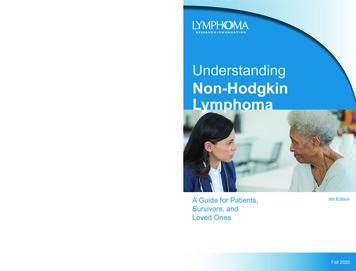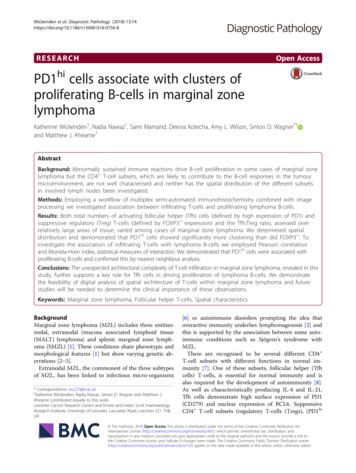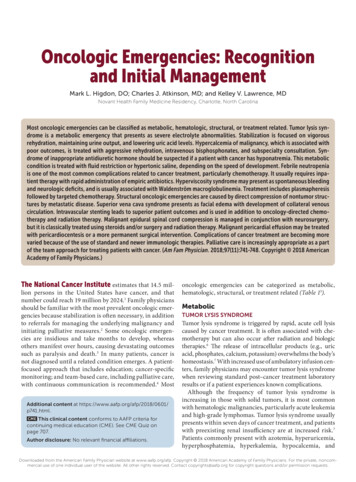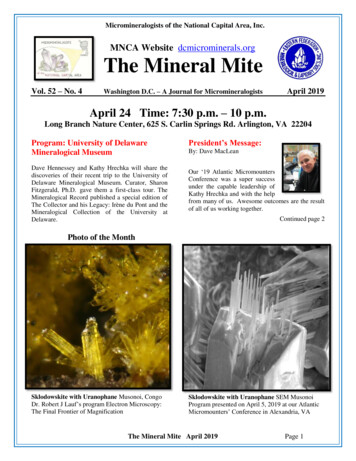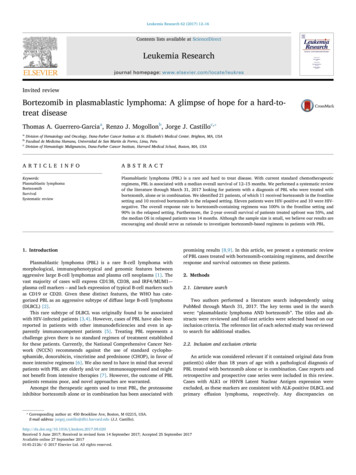
Transcription
Leukemia Research 62 (2017) 12–16Contents lists available at ScienceDirectLeukemia Researchjournal homepage: www.elsevier.com/locate/leukresInvited reviewBortezomib in plasmablastic lymphoma: A glimpse of hope for a hard-totreat diseaseThomas A. Guerrero-Garciaa, Renzo J. Mogollonb, Jorge J. Castilloc,abcMARK⁎Division of Hematology and Oncology, Dana-Farber Cancer Institute at St. Elizabeth’s Medical Center, Brighton, MA, USAFacultad de Medicina Humana, Universidad de San Martin de Porres, Lima, PeruDivision of Hematologic Malignancies, Dana-Farber Cancer Institute, Harvard Medical School, Boston, MA, USAA R T I C L E I N F OA B S T R A C TKeywords:Plasmablastic lymphomaBortezomibSurvivalSystematic reviewPlasmablastic lymphoma (PBL) is a rare and hard to treat disease. With current standard chemotherapeuticregimens, PBL is associated with a median overall survival of 12–15 months. We performed a systematic reviewof the literature through March 31, 2017 looking for patients with a diagnosis of PBL who were treated withbortezomib, alone or in combination. We identified 21 patients, of which 11 received bortezomib in the frontlinesetting and 10 received bortezomib in the relapsed setting. Eleven patients were HIV-positive and 10 were HIVnegative. The overall response rate to bortezomib-containing regimens was 100% in the frontline setting and90% in the relapsed setting. Furthermore, the 2-year overall survival of patients treated upfront was 55%, andthe median OS in relapsed patients was 14 months. Although the sample size is small, we believe our results areencouraging and should serve as rationale to investigate bortezomib-based regimens in patients with PBL.1. IntroductionPlasmablastic lymphoma (PBL) is a rare B-cell lymphoma withmorphological, immunophenotypical and genomic features betweenaggressive large B-cell lymphomas and plasma cell neoplasms [1]. Thevast majority of cases will express CD138, CD38, and IRF4/MUM1–plasma cell markers – and lack expression of typical B-cell markers suchas CD19 or CD20. Given these distinct features, the WHO has categorized PBL as an aggressive subtype of diffuse large B-cell lymphoma(DLBCL) [2].This rare subtype of DLBCL was originally found to be associatedwith HIV-infected patients [3,4]. However, cases of PBL have also beenreported in patients with other immunodeficiencies and even in apparently immunocompetent patients [5]. Treating PBL represents achallenge given there is no standard regimen of treatment establishedfor these patients. Currently, the National Comprehensive Cancer Network (NCCN) recommends against the use of standard cyclophosphamide, doxorubicin, vincristine and prednisone (CHOP), in favor ofmore intensive regimens [6]. We also need to have in mind that severalpatients with PBL are elderly and/or are immunosuppressed and mightnot benefit from intensive therapies [7]. However, the outcome of PBLpatients remains poor, and novel approaches are warranted.Amongst the therapeutic agents used to treat PBL, the proteasomeinhibitor bortezomib alone or in combination has been associated with⁎promising results [8,9]. In this article, we present a systematic reviewof PBL cases treated with bortezomib-containing regimens, and describeresponse and survival outcomes on these patients.2. Methods2.1. Literature searchTwo authors performed a literature search independently usingPubMed through March 31, 2017. The key terms used in the searchwere: “plasmablastic lymphoma AND bortezomib”. The titles and abstracts were reviewed and full-text articles were selected based on ourinclusion criteria. The reference list of each selected study was reviewedto search for additional studies.2.2. Inclusion and exclusion criteriaAn article was considered relevant if it contained original data frompatient(s) older than 18 years of age with a pathological diagnosis ofPBL treated with bortezomib alone or in combination. Case reports andretrospective and prospective case series were included in this review.Cases with ALK1 or HHV8 Latent Nuclear Antigen expression wereexcluded, as these markers are consistent with ALK-positive DLBCL andprimary effusion lymphoma, respectively. Any discrepancies onCorresponding author at: 450 Brookline Ave, Boston, M 02215, USA.E-mail address: jorgej castillo@dfci.harvard.edu (J.J. .09.020Received 5 June 2017; Received in revised form 14 September 2017; Accepted 25 September 2017Available online 27 September 20170145-2126/ 2017 Elsevier Ltd. All rights reserved.
Leukemia Research 62 (2017) 12–16T.A. Guerrero-Garcia et al.inclusion or exclusion of a study were resolved through consensus in allcases. If there were multiple publications from the same study, only themost recent was selected, using the older publications only to clarifymethodology or characteristics of the population.Table 2Selected pathological characteristics of patients with plasmablastic lymphoma treatedwith bortezomib alone or in combination.2.3. Data gatheringThe data extraction was performed independently by two authors,and included pertinent clinical (e.g. age, sex, stage, HIV status, etc.),pathological (e.g. CD20, CD38, EBER, etc.), treatment, response andoverall survival (OS) data. For response assessment, we used the 2007Cheson response criteria, whenever possible [10]. OS was defined asthe time from PBL diagnosis and death or last follow-up, and was estimated using the Kaplan-Meier method for incomplete observations.Comparisons between groups were performed using the log-rank test.All calculations and graphs were obtained using STATA/SE 13.1 (StataCorp, College Station, TX).Pathological featuresFrontline (n 11)Relapsed (n 10)CD20CD38/CD138Ki67 expression 80%MYC rearrangementEBER positiveHHV-8 LANAALK10/11 (0%)11/11 (100%)7/11 (78%)6/7 (86%)6/9 (67%)0/6 (0%)0/4 (0%)1/10 (10%)10/10 (100%)4/5 (80%)NR0/4 (0%)0/3 (0%)0/1 (0%)EBER: EBV-encoded RNA; LANA: latent nuclear antigen; ALK1: anaplastic lymphomakinase 1.(16%) HIV-negative patients tested. HHV8 LANA and ALK1 expressionwas not identified in any of the tested cases. Selected pathologicalcharacteristics are shown in Table 2.3. Results3.2. Treatment and outcomes3.1. Patient characteristicsIn the frontline setting, the overall response rate (ORR) to bortezomib-based regimens was 100%, with complete response (CR) seen in89% of patients. The response to bortezomib alone in the frontlinesetting was also 100% but all cases achieved a partial response (PR). Inthe relapsed setting, the ORR to bortezomib-based regimens was also100% but the CR rate was 16%. In relapsed patients, the ORR to bortezomib alone was 75% but no CR was seen, and one patient (25%) hadprogressive disease. Response results are shown in Table 3. With amedian follow-up time of 22 months, the median OS time of PBL patients treated with bortezomib-based regimens upfront was notreached. The 2-year OS rate was 55% (95% CI 23–78%; Fig. 1A). TheOS of patients who received bortezomib alone upfront was shorter thanpatients who received bortezomib in combination (Fig. 2B). Of the fivedeaths, 3 were due to infections (2 sepsis and 1 progressive multifocalleukoencephalopathy) without evidence disease, and 2 were due to PBLrelapse and progression. After a median follow-up time of 24 months,the median OS of PBL patients who received bortezomib-based regimens in the relapsed setting was 14 months with a 2-year OS rate of27% (Fig. 2A). There was no apparent difference in OS between receiving bortezomib alone or in combination (Fig. 2B). The cause ofdeath in all patients with relapsed PBL was progressive disease.The literature search rendered 22 articles of which 9 articles wereexcluded; 4 were reviews, 3 reported on plasmablastic myeloma and 2were pre-clinical. From the remaining 13 articles, a total of 21 patientsmet inclusion criteria and were included in this study [8,9,11–21].Eleven patients received bortezomib-containing regimens in the frontline setting, and ten patients received bortezomib-containing regimensin the relapsed and/or refractory setting.The patients’ clinical characteristics are summarized in Table 1. Themedian age for the patients with frontline use of bortezomib was 42years (range 34–80 years) and 50 years (range 19–66 years) in the relapsed group. There was a male predominance in both groups, 10 (91%)in the frontline, and 9 (90%) in the relapsed group. Eleven patients(52%) were HIV-positive. Sixteen patients (76%) had advance diseaseby Lugano staging criteria. All cases had extranodal involvement, andthe lower GI tract was the most common site of extranodal involvement(43% of the cases).Pathologically, all cases demonstrated plasmacytic differentiationby CD38/CD138 expression. Except for one HIV-positive patient, allcases tested lacked CD20 expression. A Ki67 expression 80% wasfound in eleven (52%) of the 21 patients. EBER expression was detectedin 5 of the 7 (71%) HIV-positive patients tested, as opposed to 1 of 63.3. Analysis per HIV statusTable 1Selected clinical characteristics of patients with plasmablastic lymphoma treated withbortezomib alone or in combination.Clinical featuresMedian age (range)Male sexIPI score 2Lugano stage III/IVExtranodal involvementLower GI tractHead/neckLung/pleuraBone marrowSkeletal boneOtherHIV-positive statusOn HAARTFrontline (n 11)Relapsed (n 10)42 (34–80)10 (91%)6 (60%)7 (70%)11 (100%)5 (45%)3 (27%)3 (27%)3 (27%)2 (18%)4 (36%)a6 (55%)6 (100%)49.5 (19–66)9 (90%)4 (44%)9 (90%)10 (100%)4 (40%)2 (20%)1 (10%)2 (20%)3 (30%)3 (30%)b5 (50%)2 (40%)Out of the 21 patients with PBL, eleven (52%) had HIV infection. Allpatients in the bortezomib frontline group were on highly active antiretroviral therapy. Of the 11 HIV-positive patients, 5 patients (45%)had a complete response (CR), 5 (45%) had a partial response and 1Table 3Response of plasmablastic lymphoma patients to bortezomib alone or in combination.bTHP-COP-bortezomib (n 1), bortezomib-ESHAP (n 1), bortezomib-ICE (n 1),bendamustine-bortezomib (n 1), bortezomib-rituximab (n 1), VDT-PACE (n 1).TreatmentBortezomib-chemoComplete responsePartial responseBortezomib aloneComplete responsePartial responseProgressive diseaseIPI: International Prognostic Index; GI: gastrointestinal; HAART: highly active antiretroviral therapy.aOther sites include central nervous system (n 1), testicle (n 1), liver (n 1), skin(n 1)bOther sites include skin (n 1), spleen (n 1), muscle (n 1)aFrontline (n sed (n zomib-EPOCH (n 4), bortezomib-CHOP (n 3), R-CYBORD (n 1), PAD(n 1).bTHP-COP-bortezomib (n 1), bortezomib-ESHAP (n 1), bortezomib-ICE (n 1),bendamustine-bortezomib (n 1), bortezomib-rituximab (n 1), VDT-PACE (n 1).13
Leukemia Research 62 (2017) 12–16T.A. Guerrero-Garcia et al.Fig. 1. Median OS curve of PBL patients who received frontline bortezomib-containing regimens(A), and in PBL patients who received upfront bortezomib alone or in combination (B).PBL treated upfront with standard chemotherapy regimens. The 2-yearOS rate in PBL patients treated upfront with bortezomib-based regimenswas 55% with a median OS that was not reached at 24 months offollow-up. As an aggressive lymphoma, most relapses are expected tooccur within a 2-year interval. One could speculate that patients alive at2 years could be cured from the disease.Given the rarity of PBL, one tends to evaluate patients regardless ofHIV status. There is, however, mounting evidence that HIV-positive andHIV-negative patients might have different clinical course and survival.In an initial comparative study, HIV-negative PBL patients were olderand were less likely to obtain CR to chemotherapy. Also, HIV-negativepatients had a worse OS than HIV-positive patients of 9 months and 15months, respectively [29]. In this systematic review, HIV-negative PBLpatients have lower rates of CR and probably a worse outcome as well.However, the sample size does not permit strong statements. Previousstudies have shown that autologous hematopoietic stem cell transplantin first CR might increase survival in PBL patients [30,31].Recent case series have reported high success rates with the use ofbortezomib upfront in combination with commonly used regimens inlymphoma such as EPOCH or CHOP. These results are the most promising results found in the literature in regards to overall length ofsurvival in PBL patients [8,9,17]. If EPOCH is more effective at inducingresponses and improve survival in PBL is unclear. A recent patient-levelmeta-analysis provided higher-level evidence that EPOCH might be abetter option than CHOP in patients with HIV-associated lymphomas byinducing higher rates of event-free survival (EFS) as well as OS [32].More recently, results from the highly anticipated Alliance 50303showed that, with a median follow-up of 5 years, there was no difference in EFS or OS between R-CHOP and R-EPOCH in patients withDLBCL [33]. However, subset analyses evaluating high-risk patientswere not reported.Bortezomib is a proteasome inhibitor approved for the treatment ofmultiple myeloma, and there is emerging evidence of its efficacy in nongerminal DLBCL [34]. Bortezomib has also shown preclinical andclinical activity in other CD20-negative lymphomas such as primaryeffusion lymphoma [35–37]. Therefore, bortezomib presents itself as apromising alternative for the treatment of PBL. PBL cells are characterized by the expression of plasma cell transcription factors such as(10%) had progression of disease (PD) while undergoing therapy. In thefrontline setting, the 5 patients who received bortezomib in combination (CHOP or EPOCH) had a CR rate of 100%. The one patient treatedwith bortezomib alone experienced a PR. For the 10 HIV negative patients, 3 patients (30%) achieved a CR and 7 (70%) had a PR. In thefrontline setting, the 3 patients (60%) who achieved a CR receivedbortezomib in combination (CYBORD or EPOCH).3.4. ToxicityGrade 3 neuropathy was reported in 20% of patients. The combination of bortezomib-chemotherapy resulted in grade 2–4 anemia,neutropenia and thrombocytopenia. Grade 2–3 urinary and respiratoryinfections and zoster reactivations were also reported. One patient experienced small bowel obstruction needing partial small bowel resection. Febrile neutropenia was not reported as a complication.4. DiscussionIn this systematic review, we searched for PBL cases treated withbortezomib-based regimens, and identified a total of 21 cases.Currently, there is no standard treatment regimen for PBL. CurrentNCCN guidelines recommend regimens like DA-EPOCH, HyperCVADand CODOX-M/IVAC based on studies largely incorporating other aggressive lymphomas like Burkitt lymphoma, and almost always in thesetting of HIV infection [22–24]. However, none of these seem to havechanged the survival of patients with PBL, and current data does notsupport that more intensive regimens improve outcomes in PBL[25,26]. Standard chemotherapy and survival continues to be poor witha median survival that ranges between 9 and 15 months [25,27,28].In these 21 cases of PBL, treatment with bortezomib exhibitedpromising results with regard to response and OS rates. ORR rates ofalmost 100% were reported in both the frontline and relapsed settings.Furthermore, bortezomib-based regimens can induce high rates of CR,which is highly encouraging. Previous studies have shown the importance of inducing deep responses in patients with PBL [25,26]. Withregards to survival, a median OS of 14 months was observed in therelapsed group, which is comparable to the survival of patients withFig. 2. Median OS curve of PBL patients who received bortezomib-containing regimens in the relapsed setting (A), and in PBL patients who receivedbortezomib alone or in combination (B).14
Leukemia Research 62 (2017) 12–16T.A. Guerrero-Garcia et al.(2009) 490–492.[14] C. Cao, T. Liu, H. Zhu, L. Wang, S. Kai, Xiang B. Bortezomib-ContainedChemotherapy, Thalidomide combined with CHOP (cyclophosphamide, doxorubicin, vincristine, and prednisone) play promising roles in plasmablastic lymphoma: a case report and literature review, Clin. Lymphoma Myeloma Leuk. 14(2014) e145–150.[15] E. Cencini, A. Fabbri, S. Guerrini, M.A. Mazzei, V. Rossi, M. Bocchia, Long-termremission in a case of plasmablastic lymphoma treated with COMP (cyclophosphamide, liposomal doxorubicin, vincristine, prednisone) and bortezomib, Eur. J.Haematol. 96 (2016) 650–654.[16] C.A. Dasanu, F. Bauer, I. Codreanu, P. Padmanabhan, M. Rampurwala,Plasmablastic haemato-lymphoid neoplasm with a complex genetic signature ofBurkitt lymphoma responding to bortezomib, Hematol. Oncol. 31 (2013) 164–166.[17] P.L. Fedele, G.P. Gregory, M. Gilbertson, J. Shortt, B. Kumar, S. Opat, et al.,Infusional dose-adjusted epoch plus bortezomib for the treatment of plasmablasticlymphoma, Ann. Hematol. 95 (2016) 667–668.[18] M. Hirosawa, H. Morimoto, R. Shibuya, S. Shimajiri, J. Tsukada, A striking responseof plasmablastic lymphoma of the oral cavity to bortezomib: a case report, Biomark.Res. 3 (2015) 28.[19] M. Lipstein, O. O'Connor, F. Montanari, L. Paoluzzi, D. Bongero, G. Bhagat,Bortezomib-induced tumor lysis syndrome in a patient with HIV-negative plasmablastic lymphoma, Clin. Lymphoma Myeloma Leuk. 10 (2010) E43–E46.[20] N.S. Saba, D. Dang, J. Saba, C. Cao, M. Janbain, B. Maalouf, et al., Bortezomib inplasmablastic lymphoma: a case report and review of the literature, Onkologie 36(2013) 287–291.[21] M. Yan, Z. Dong, F. Zhao, T. Chauncey, D. Deauna-Limayo, J. Wang-Rodriguez,et al., CD20-positive plasmablastic lymphoma with excellent response to bortezomib combined with rituximab, Eur. J. Haematol. 93 (2014) 77–80.[22] R.F. Little, S. Pittaluga, N. Grant, S.M. Steinberg, M.F. Kavlick, H. Mitsuya, et al.,Highly effective treatment of acquired immunodeficiency syndrome-related lymphoma with dose-adjusted EPOCH: impact of antiretroviral therapy suspension andtumor biology, Blood 101 (2003) 4653–4659.[23] A. Noy, J.Y. Lee, E. Cesarman, R. Ambinder, R. Baiocchi, E. Reid, et al., AMC 048:modified CODOX-M/IVAC-rituximab is safe and effective for HIV-associated Burkittlymphoma, Blood 126 (2015) 160–166.[24] D.A. Thomas, S. Faderl, S. O'Brien, C. Bueso-Ramos, J. Cortes, G. Garcia-Manero,et al., Chemoimmunotherapy with hyper-CVAD plus rituximab for the treatment ofadult Burkitt and Burkitt-type lymphoma or acute lymphoblastic leukemia, Cancer106 (2006) 1569–1580.[25] J.J. Castillo, M. Furman, B.E. Beltran, M. Bibas, M. Bower, W. Chen, et al., Humanimmunodeficiency virus-associated plasmablastic lymphoma: poor prognosis in theera of highly active antiretroviral therapy, Cancer 118 (2012) 5270–5277.[26] J.J. Castillo, E.S. Winer, D. Stachurski, K. Perez, M. Jabbour, C. Milani, et al.,Prognostic factors in chemotherapy-treated patients with HIV-associatedPlasmablastic lymphoma, Oncologist 15 (2010) 293–299.[27] J. Morscio, D. Dierickx, J. Nijs, G. Verhoef, E. Bittoun, X. Vanoeteren, et al.,Clinicopathologic comparison of plasmablastic lymphoma in HIV-positive, immunocompetent, and posttransplant patients: single-center series of 25 cases andmeta-analysis of 277 reported cases, Am. J. Surg. Pathol. 38 (2014) 875–886.[28] P. Schommers, C. Wyen, M. Hentrich, D. Gillor, A. Zoufaly, B. Jensen, et al., Pooroutcome of HIV-infected patients with plasmablastic lymphoma: results from theGerman. AIDS-related lymphoma cohort study, AIDS 27 (2013) 842–845.[29] J.J. Castillo, E.S. Winer, D. Stachurski, K. Perez, M. Jabbour, C. Milani, et al.,Clinical and pathological differences between human immunodeficiency virus-positive and human immunodeficiency virus-negative patients with plasmablasticlymphoma, Leuk. Lymphoma 51 (2010) 2047–2053.[30] J.J. Liu, L. Zhang, E. Ayala, T. Field, J.L. Ochoa-Bayona, L. Perez, et al., Humanimmunodeficiency virus (HIV)-negative plasmablastic lymphoma: a single institutional experience and literature review, Leuk. Res. 35 (2011) 1571–1577.[31] M.M. Al-Malki, J.J. Castillo, J.M. Sloan, A. Re, Hematopoietic cell transplantationfor plasmablastic lymphoma: a review, Biol. Blood Marrow Transplant. 20 (2014)1877–1884.[32] S.K. Barta, J.Y. Lee, L.D. Kaplan, A. Noy, J.A. Sparano, Pooled analysis of AIDSmalignancy consortium trials evaluating rituximab plus CHOP or infusional EPOCHchemotherapy in HIV-associated non-Hodgkin lymphoma, Cancer 118 (2012)3977–3983.[33] W.H. Wilson, J. sin-Ho, B.N. Pitcher, E.D. Hsi, J. Friedberg, B. Cheson, et al., PhaseIII randomized study of R-CHOP versus DA-EPOCH-R and molecular analysis ofuntreated diffuse large B-Cell lymphoma: CALGB/Alliance 50303, Blood 128 (2016)469.[34] K. Dunleavy, S. Pittaluga, M.S. Czuczman, S.S. Dave, G. Wright, N. Grant, et al.,Differential efficacy of bortezomib plus chemotherapy within molecular subtypes ofdiffuse large B-cell lymphoma, Blood 113 (2009) 6069–6076.[35] J. An, Y. Sun, M. Fisher, M.B. Rettig, Antitumor effects of bortezomib (PS-341) onprimary effusion lymphomas, Leukemia 18 (2004) 1699–1704.[36] E. Boulanger, V. Meignin, E. Oksenhendler, Bortezomib (PS-341) in patients withhuman herpesvirus 8-associated primary effusion lymphoma, Br. J. Haematol. 141(2008) 559–561.[37] K.A. Sarosiek, L.E. Cavallin, S. Bhatt, N.L. Toomey, Y. Natkunam, W. Blasini, et al.,Efficacy of bortezomib in a direct xenograft model of primary effusion lymphoma,Proc. Natl. Acad. Sci. U. S. A. 107 (2010) 13069–13074.[38] S. Montes-Moreno, A.R. Gonzalez-Medina, S.M. Rodriguez-Pinilla, L. Maestre,L. Sanchez-Verde, G. Roncador, et al., Aggressive large B-cell lymphoma withplasma cell differentiation: immunohistochemical characterization of plasmablasticlymphoma and diffuse large B-cell lymphoma with partial plasmablastic phenotype,Haematologica 95 (2010) 1342–1349.LRF4, BLIMP1 and XBP1 [1,38]. Expression of XBP1 and BLIMP1 hasbeen associated with the efficacy of bortezomib in myeloma, likely dueto driving anti- body production and hence reliance on the unfoldedprotein response [39–41].Despite its retrospective design and small number of patients, weprovide perhaps the most updated information about response andsurvival of PBL patients treated with bortezomib-based regimens. PBLwill continue being a diagnostic challenge given its features betweenlymphoma and myeloma. It will also continue being a therapeuticchallenge given its aggressiveness and lack of effective treatments.Perhaps in the era of novel agents in the field of multiple myeloma, wecan deploy these agents to see whether mechanistically they could haveany effect in PBL patients. For example, it would be of interest toevaluate the anti-CD38 monoclonal antibody daratumumab in patientswith PBL given the almost universal expression of CD38 by PBL cells. Inthe small proportion of PBL cases expressing CD30, the antibody-drugconjugate brentuximab vedotin could be of value [42]. Finally, MYCdirected therapies can prove efficacious against PBL cases with MYCgene rearrangements.5. ConclusionIn summary, we have observed higher response and survival rates inPBL patients treated with bortezomib-based regimens in the frontlinesetting, and impressive transient responses in relapsed cases. Largermulti-institutional studies will need to confirm these observations. Wehope the evidence presented here can help inform therapeutic decisionsclinicians and patients faced with this rare and aggressive disease.AcknowledgementThere was no specific funding for this manuscript.References[1] J.J. Castillo, M. Bibas, R.N. Miranda, The biology and treatment of plasmablasticlymphoma, Blood 125 (2015) 2323–2330.[2] S.H. Swerdlow, E. Campo, S.A. Pileri, N.L. Harris, H. Stein, R. Siebert, et al., The2016 revision of the World Health Organization classification of lymphoid neoplasms, Blood 127 (2016) 2375–2390.[3] J. Castillo, L. Pantanowitz, B.J. Dezube, HIV-associated plasmablastic lymphoma:lessons learned from 112 published cases, Am. J. Hematol. 83 (2008) 804–809.[4] H.J. Delecluse, I. Anagnostopoulos, F. Dallenbach, M. Hummel, T. Marafioti,U. Schneider, et al., Plasmablastic lymphomas of the oral cavity: a new entity associated with the human immunodeficiency virus infection, Blood 89 (1997)1413–1420.[5] J.J. Castillo, E.S. Winer, D. Stachurski, K. Perez, M. Jabbour, C. Milani, et al., HIVnegative plasmablastic lymphoma: not in the mouth, Clin. Lymphoma MyelomaLeuk. 11 (2011) 185–189.[6] NCCN Guidelines Version 3.2017. AIDS-Related B-Cell Lymphomas. AIDS-4.Available at http://www.nccn.org/professionals/physician gls/pdf/nhl.pdf.(Accessed 30 May 2017).[7] D.A. Rizzieri, J.L. Johnson, J.C. Byrd, G. Lozanski, K.A. Blum, B.L. Powell, et al.,Improved efficacy using rituximab and brief duration, high intensity chemotherapywith filgrastim support for Burkitt or aggressive lymphomas: cancer and LeukemiaGroup B study 10 002, Br. J. Haematol. 165 (2014) 102–111.[8] J.J. Castillo, J.L. Reagan, W.M. Sikov, E.S. Winer, Bortezomib in combination withinfusional dose-adjusted EPOCH for the treatment of plasmablastic lymphoma, Br.J. Haematol. 169 (2015) 352–355.[9] R. Fernandez-Alvarez, A.P. Gonzalez-Rodriguez, A. Rubio-Castro, M.E. Gonzalez,A.R. Payer, A. Alonso-Garcia, et al., Bortezomib plus CHOP for the treatment ofHIV-associated plasmablastic lymphoma: clinical experience in three patients, Leuk.Lymphoma (2015) 1–4.[10] B.D. Cheson, B. Pfistner, M.E. Juweid, R.D. Gascoyne, L. Specht, S.J. Horning, et al.,Revised response criteria for malignant lymphoma, J. Clin. Oncol. 25 (2007)579–586.[11] M. Akce, E. Chang, M. Haeri, M. Perez, C.J. Finch, M.M. Udden, et al., Bortezomib,ifosfamide, carboplatin, and etoposide in a patient with HIV-Negative relapsedplasmablastic lymphoma, Case Rep. Hematol. 2016 (2016) 3598547.[12] M. Bibas, S. Grisetti, L. Alba, G. Picchi, F. Del Nonno, A. Antinori, Patient with HIVassociated plasmablastic lymphoma responding to bortezomib alone and in combination with dexamethasone, gemcitabine, oxaliplatin, cytarabine, and pegfilgrastim chemotherapy and lenalidomide alone, J. Clin. Oncol. 28 (2010) e704–708.[13] P. Bose, C. Thompson, D. Gandhi, B. Ghabach, H. Ozer, AIDS-related plasmablasticlymphoma with dramatic, early response to bortezomib, Eur. J. Haematol. 8215
Leukemia Research 62 (2017) 12–16T.A. Guerrero-Garcia et al.[41] N. Taubenheim, D.M. Tarlinton, S. Crawford, L.M. Corcoran, P.D. Hodgkin,S.L. Nutt, High rate of antibody secretion is not integral to plasma cell differentiation as revealed by XBP-1 deficiency, J. Immunol. 189 (2012) 3328–3338.[42] B.M. Holderness, S. Malhotra, N.B. Levy, A.V. Danilov, Brentuximab vedotin demonstrates activity in a patient with plasmablastic lymphoma arising from abackground of chronic lymphocytic leukemia, J. Clin. Oncol. 31 (2013) e197–e199.[39] C. Leung-Hagesteijn, N. Erdmann, G. Cheung, J.J. Keats, A.K. Stewart, D.E. Reece,et al., Xbp1s-negative tumor B cells and pre-plasmablasts mediate therapeuticproteasome inhibitor resistance in multiple myeloma, Cancer Cell 24 (2013)289–304.[40] S.C. Ling, E.K. Lau, A. Al-Shabeeb, A. Nikolic, A. Catalano, H. Iland, et al., Responseof myeloma to the proteasome inhibitor bortezomib is correlated with the unfoldedprotein response regulator XBP-1, Haematologica 97 (2012) 64–72.16
Bortezomib-chemo 9 (82%)a 6 (60%)b Complete response 8 (89%) 1 (16%) Partial response 1 (11%) 5 (84%) Bortezomib alone 2 (18%) 4 (40%) . VDT-PACE (n 1). T.A. Guerrero-Garcia et al. Leukemia Research 62 (2017) 12-16 13 (10%) had progression of disease (PD) while undergoing therapy. In the frontline setting, the 5 patients who received .


